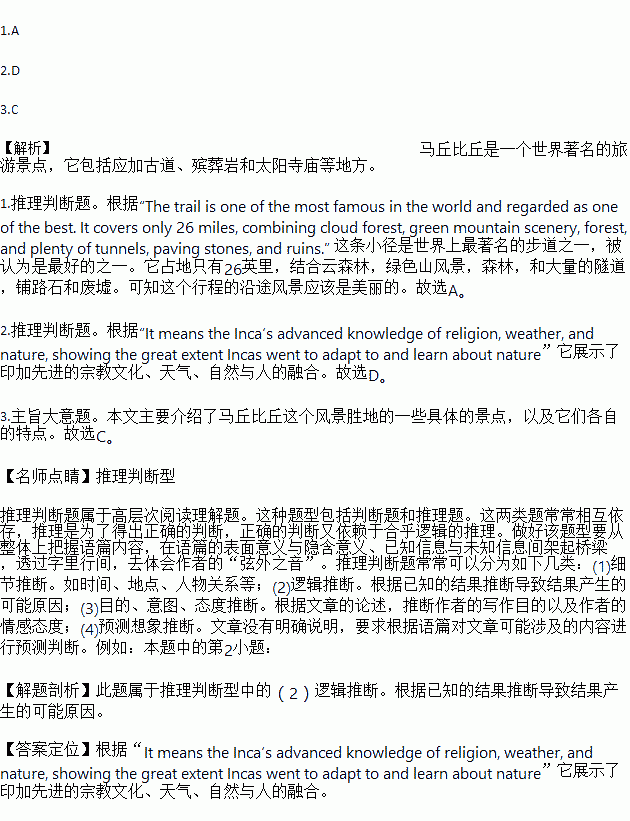题目内容
Machu Picchu is an unusual site in Peru and one of the most mysterious wonders of the world. Built at almost 10,000 feet on the top of an Andean mountain, the Incas built hundreds of structures made of stone. A large number of Machu Picchu’s surrounding structures date back to the early 13th century, but it was considered a chief sacred site far before then. The Inca people changed the large site into a very small but wonderful city, completely self-sufficient and hidden from below. Agricultural terraces (梯田) surrounded the entire city, fed by natural spring water, supporting the entire population.
Inca Trail
The trail is one of the most famous in the world and regarded as one of the best. It covers only 26 miles, combining cloud forest, green mountain scenery, forest, and plenty of tunnels, paving stones, and ruins. The four-day hike begins slowly but quickly changes into a difficult journey suitable for those in excellent shape. The trail winds through the Andes, leading alongside and through ruins. Though independent hiking was once permitted, now it must be done with a guide.
Funerary Rock
It is believed that the Funerary Rock at Machu Picchu was used as a place to prepare Inca nobles for preservation, or mummifying (做成木乃伊), a common habit among the tribe. Nobles would be laid out to be mummified by the hot sun and freezing cold nights after their organs were removed. The rock is also famous as a spot from which a view of the city is afforded.
Temple of the Sun
Within the city’s castle, deep within Machu Picchu, is the Temple of the Sun, accessed only by the Emperor and
Inca priests. It means the Inca’s advanced knowledge of religion, weather, and nature, showing the great extent
Incas went to adapt to and learn about nature. Still unbroken, the temple was built to honor the god Inti, who is exactly the sun. The temple was effectively protected. It was also a very important scientific center, built in half-moon shape with openings facing north and east. The windows’ shadows in the center of the temple helped see the start of winter solstice (至日), showing farming season.
1.What do we know about the Inca Trail?
A. The scene is very beautiful along the trail.
B. One person alone is permitted to hike on the trail.
C. Only healthy people can do the four-day hike trail.
D. The trail covers a distance of 80 miles in all.
2.Temple of the Sun suggests that .
A. Incas had a good knowledge of math
B. Incas are rich in farming experiences
C. Inca had a desire to go to the moon
D. Incas adapted and learned about nature
3.What can be the best title for the passage?
A. Inca Trail B. Funerary Rock
C. Machu Picchu D. Temple of the Sun

